Day 3 of a long weekend of tours today, our last day, and a day of general birding along the coast. We were trying to catch up with a few of the good birds around Norfolk at the moment which we hadn’t seen yet this weekend. Depending which weather forecast you looked at, it was either going to rain all day or just some heavy rain around the middle of the day. As it was, it did neither and was a lot better than expected. A bonus! We met in Wells and made our way west along the coast road.
We hadn’t gone far when we made our first impromptu stop. A Barn Owl was hunting over a field beside the road, head down, focused intently on the ground below. We watched it for a minute or so, flying round, before it disappeared out of view behind a hedge.
One a short distance further along the road, we had to make another stop for another Barn Owl, this one perched on a post. Despite our best efforts, it flew off just as we got out and circled round the field hunting. It then had second thoughts and came back to perch on the post again, just so we could have a good look at it! Then it was off hunting over the grass once more. Two Barn Owls – a great way to start the day.
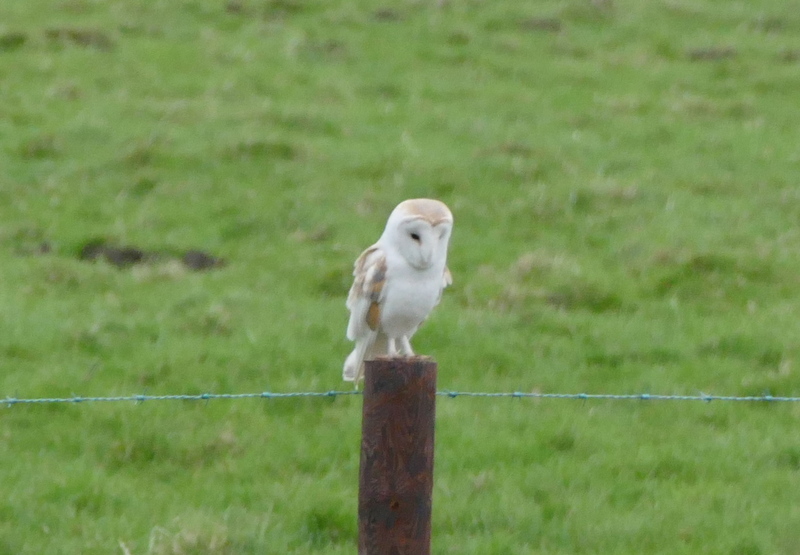 Barn Owl – our second of the morning
Barn Owl – our second of the morning
Brancaster Staithe is always a nice place to stop, with a good selection of waders in the harbour and normally a few Red-breasted Mergansers in the channel. There had been a Red-necked Grebe here for much of December, going missing for a fortnight before reappearing again for a week in mid January. It had not been seen since 15th January, so we weren’t expecting to see it, but we had a good scan of the harbour just in case. We had to content ourselves with several smart Red-breasted Mergansers this morning.
 Red-breasted Merganser – showing off his spiky punk haircut
Red-breasted Merganser – showing off his spiky punk haircut
The tide was coming in, already quite high, and there were several Bar-tailed Godwits and Dunlin feeding along the water’s edge by the car park. A Turnstone ran in front of the car across the stones. Further over were on a sandbank were several Grey Plover and Ringed Plover. A pile of debris on the shore were the mussels had been brought in and washed was being picked over by a little posse of Oystercatchers and more Turnstones.
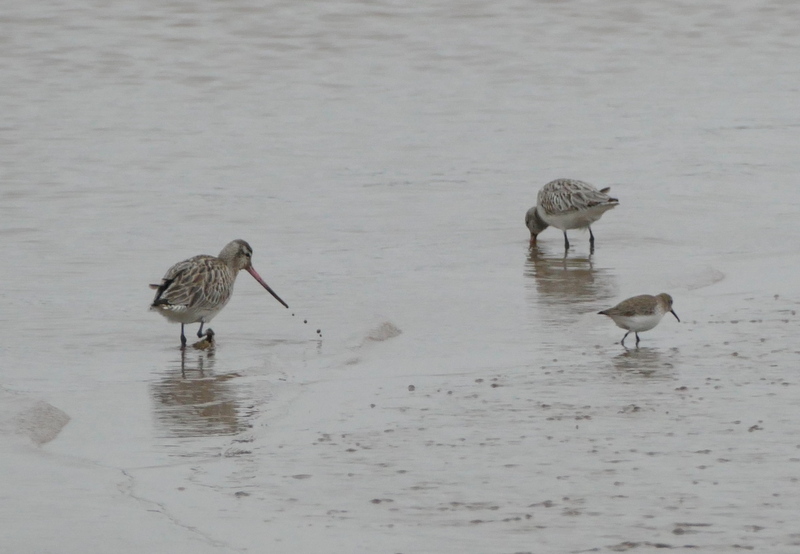 Bar-tailed Godwits & Dunlin – by the car park at Brancaster Staithe
Bar-tailed Godwits & Dunlin – by the car park at Brancaster Staithe
Having had a good look round, we decided to press on, cutting inland towards Docking. We stopped to scan some trees in the hope of finding the Rough-legged Buzzard on one of its favourite perches. We couldn’t see it, but while we were watching a flock of Chaffinches and Yellowhammer feeding on the edge of a field, a ghostly grey shape appeared over a cover strip the other side. A stunning male Hen Harrier, it was hunting low over the ground and against the dark trees in the background we could see the black wing tips contrasting with the silvery grey upperparts. It got to the back of the field and dropped down over the ridge the other side out of view.
We hopped in the car and drove round, in the hope that we might be able to find it again, but it was gone. So we carried on along the road, scanning the trees and hedges. At only our second stop, we found the Rough-legged Buzzard. It was perched on the top of a hedge – its very white head stood out a mile off. We got it in the scope for a closer look – we could even see the feathered tarsi (bottom half of its legs) from which it gets its name.
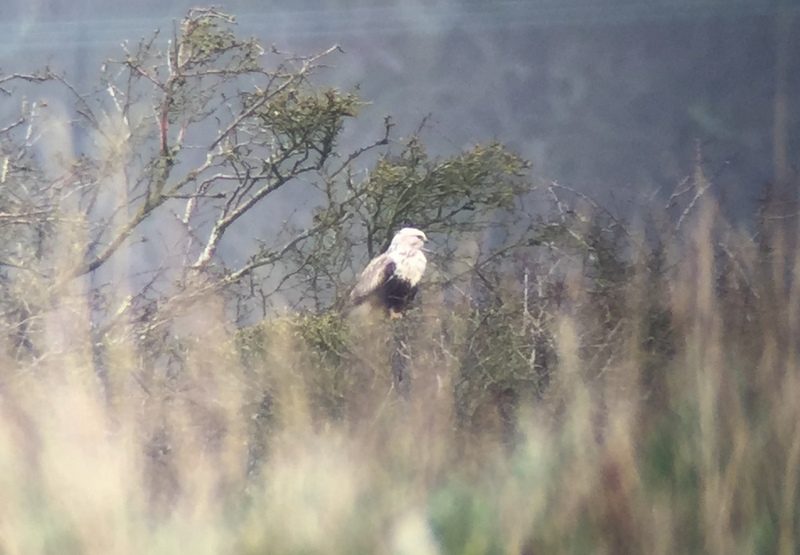 Rough-legged Buzzard – around Choseley again today
Rough-legged Buzzard – around Choseley again today
The Rough-legged Buzzard dropped down to the ground and appeared to land, but shortly after we picked it up again flying low along the hedge line, before swooping up to land in one of its favourite trees. It was round the other side of the tree, out of view from here, so we drove back round to where we had been looking earlier. We were much closer, but the view wasn’t much better from here – we could see its head and shoulders above the branches. It perched for a while, before dropping down out of the tree and flying off – we were treated to great flight views as it did so, flashing its mostly white tail with just a black terminal band. Great stuff.
A little further along the road we stopped again to count the Brown Hares. There were at least ten in one field and another four in a smaller field next door. Most of them were hunkered down, but a couple were sitting up feeding. At one point they had a half-hearted chase, before resuming what they were doing. It was probably a bit too cold and damp to expect much boxing today.
We made a quick detour round by an area where we had seen Corn Buntings in the past few weeks. They had been a little erratic more recently, so we weren’t expecting much. As we drove along the road, we could see a large flock of Linnets circling over the field. Then a little group of Skylarks got up as well. The next thing we know a flock of buntings flew across the road in front of us and landed in the hedge the other side. We pulled into a convenient gateway and got out to have a closer look. We could see there were several Yellowhammers, but at least one had looked bulkier as they flew in.
Unfortunately, before we could get a good look at them, first a Sparrowhawk flew across the road carrying some poor unsuspecting victim – probably why everything had flown out of the field in the first place – and then a very helpful soul came bombing along the road in his Land Rover and hooted his horn at us. That was the end of the buntings, as they all burst into the air. We could hear Corn Bunting calling and saw at least one as they erupted and flew off. After a short while, the Yellowhammers started to return to the field but the only Corn Bunting we saw flew over calling, a liquid ‘ptt, ptt’, and disappeared over the horizon. We scanned the hedges as we went on, but all we could find was a large flock of Chaffinches and Linnets, although we did glimpse a Brambling briefly with them.
We made our way down to Thornham Harbour next. We didn’t see anything as we drove in, so we walked down to the edge of the creek. A Rock Pipit flew off from the edge as we approached. A Spotted Redshank called a couple of times as it flew over, but we couldn’t get onto it. Then one of the group spotted the Twite behind us, landing in the vegetation by the side of the road. We made our way back towards them and had just set up the scope for a closer look when another helpful soul, our second of the morning, came down along the rutted harbour road at high speed in his shiny Range Rover and the Twite were off again.
 Twite – 25-30 were at Thornham Harbour again today
Twite – 25-30 were at Thornham Harbour again today
The Twite landed over on the seawall, so we set off round to try again. They were rather jumpy at first and wouldn’t settle, but eventually landed down on the saltmarsh below us and resumed feeding. This time we could get them in the scope and have a proper look at them, before they made their way back to the place from which they had been flushed earlier.
The cloud was now starting to thicken and it began to spit with rain. With heavy rain forecast, we thought we would spend the middle of the day at Titchwell, with the benefit of some hides to shelter in if need be. Unusually for mid-morning on a Sunday, there were spaces in the main car park. We set out towards the visitor centre, stopping to watch a Goldcrest in the tangled branches on the way.
The feeders in front of the visitor centre were a hive of activity – Chaffinches, Greenfinches, Goldfinches and tits. A male Brambling flew off before everyone could see it and a Marsh Tit came in and out too quickly as well. A Coal Tit was more obliging. However, we were more successful round at the feeders the other side. There were several Bramblings here – at least three males and two plainer females which we saw simultaneously, so probably a few more. The males are starting to look particularly smart, bright orange breast and shoulders and increasingly black heads as the pale tips to the feathers wear off through the winter. The Marsh Tit was also more obliging on this side, though still darting in, grabbing a seed, and flying back into the bushes to eat it.
 Brambling – a smart male, with an increasingly black head
Brambling – a smart male, with an increasingly black head
 Brambling – another male, this one with a paler head still
Brambling – another male, this one with a paler head still
Unusually, there was no sign of a Water Rail in the ditches on the way out onto the reserve – there was always the way back to have another look. We stopped at the drained grazing marsh ‘pool’, and once again it was covered in Rock Pipits, at least 20 out on the mud. It took a bit of scanning, but eventually we found the Water Pipit nearby – it was remarkably well camouflaged against the grey brown mud. Compared to the Rock Pipits, the Water Pipit was much cleaner white below, with the heavy streaking more restricted to the breast.
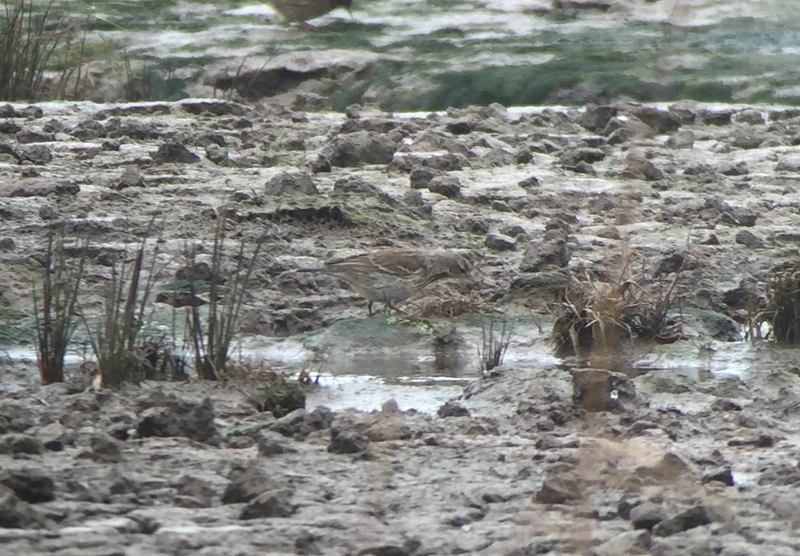 Water Pipit – well camouflaged against the mud
Water Pipit – well camouflaged against the mud
It was starting to drizzle a little harder now, so we made for the shelter of Island Hide. It was a bit of a surprise to see just how far the water levels have fallen on here in recent days. There was a lot of exposed mud, but the waders don’t seem to have read the script and there were precious few taking advantage of it. A lone Redshank was out in the middle.
 Freshmarsh – a lone Redshank on acres of mud
Freshmarsh – a lone Redshank on acres of mud
Further over, towards the back, the Avocets were at least enjoying it. They have often been asleep in recent weeks, but today they were all wide awake and feeding, sweeping their bills side to side through the shallow water. Over towards the Parrinder Hide, a couple of Black-tailed Godwits were feeding in a deeper pool.
There were not so many ducks on here today. A pair of Teal were feeding in the muddy channel below the hide, and lots more Teal were over towards the back on the open water. With them were a few Shoveler and Gadwall. A number of Brent Geese were also swimming around at the back.
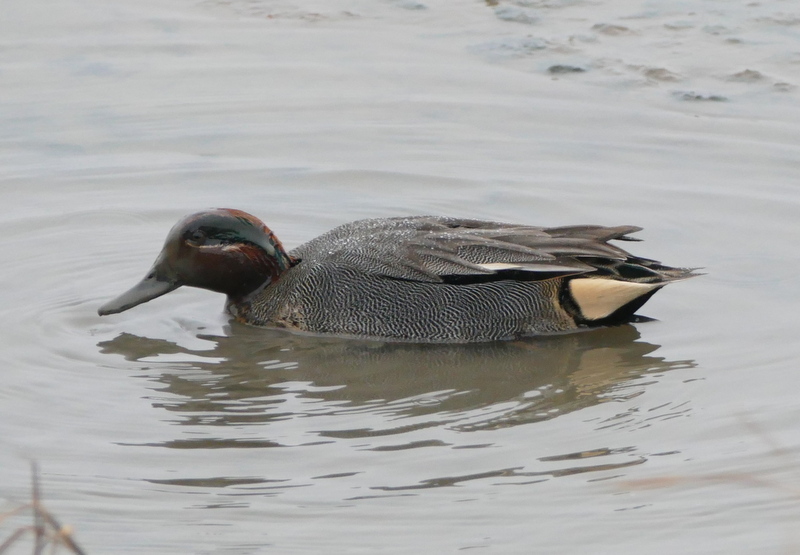 Teal – a pair were feeding in the mud below Island Hide
Teal – a pair were feeding in the mud below Island Hide
We decided to carry on out towards the beach. We were scanning from the main path when we noticed a Merlin in the air, beyond the back of the freshmarsh out towards Brancaster. We could see it was chasing a small bird – it looked like a pipit. The pipit was desperately trying to get away – climbing higher in the sky, constantly changing direction – and all the while the Merlin was stooping at it, then towering back up above it to stoop again. The two of them went high into the sky, before dropping back down sharply again, at which point we lost sight of them behind the bank. History does not relate what befell the pipit!
We stopped to have a look at Volunteer Marsh. There were several Grey Plover quite close to the main path on the mud. A Ringed Plover was there as well. A single Knot was standing on the edge of one of the channels. We were just getting the scope on it when all the waders took off – we couldn’t see what had spooked them.
 Grey Plover – there were several on the Volunteer Marsh
Grey Plover – there were several on the Volunteer Marsh
Out at the Tidal Pools, we could see several Little Grebes and several Goldeneye, all diving in the shallow water. A Cormorant was wrestling with a large eel which it had caught. The eel wrapped itself round the Cormorant’s neck, and the Cormorant kept plunging the eel into the water. At one point it even tossed it into the air and caught it again. Eventually, it worked it round so it had hold of it by its head and it managed to swallow it with a bit of effort. We could see the Cormorant‘s distended crop afterwards. When we came back from the beach it was standing on one of the islands, probably attempting to digest its huge meal!
We couldn’t find the Spotted Redshank here today, but in its place was a single Greenshank, in with the Common Redshank. There were several Bar-tailed Godwits on here and, further out by the beach, a single Black-tailed Godwit. It was now starting to drizzle harder, so we made our way out to the beach.
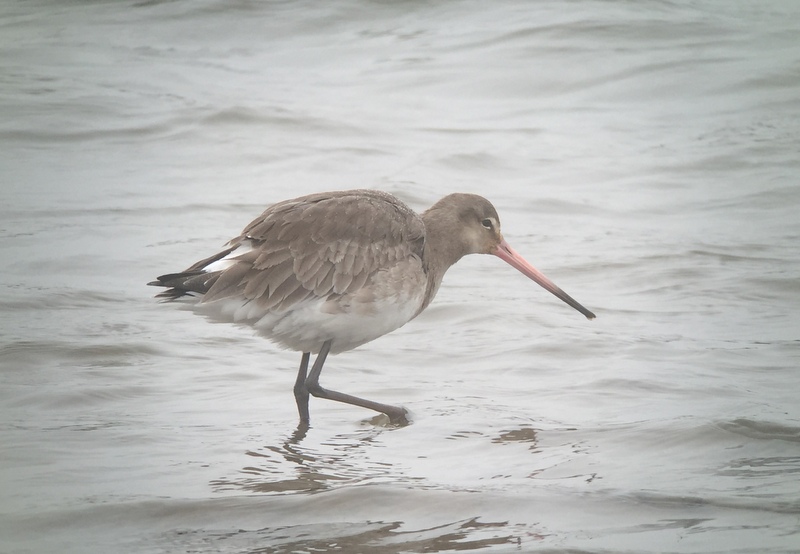 Black-tailed Godwit – on the tidal pools behind the beach
Black-tailed Godwit – on the tidal pools behind the beach
Out on the beach, the tide was now in. As a consequence, there were not so many waders as usual – just a few Oystercatchers, Bar-tailed Godwits and Sanderling. We would normally have had a good look at the sea, but the drizzle had turned to mist and we couldn’t see very far offshore at all. A couple of Common Scoters were helpfully just offshore behind the breakers, but that was all we could see. At least it gave us a good excuse to head back.
Almost back to the visitor centre, we had another good look in the ditches either side of the path. This time we found the Water Rail, lurking underneath a mass of branches over the water, preening. It was really hard to see until eventually it finished preening and came out onto the far bank, probing in amongst the rotting leaves.
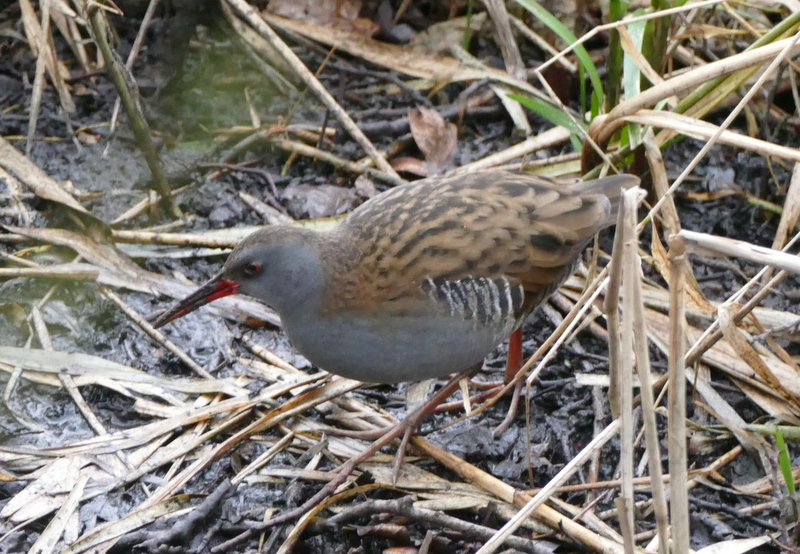 Water Rail – in the ditch by the main path again
Water Rail – in the ditch by the main path again
While we were having lunch, it stopped drizzling and started to brighten up. At the same time, some news came through – the Red-necked Grebe had reappeared, just where we had been earlier this morning. This bird is nothing if not erratic! We couldn’t let it get away with that, so after we had finished eating we made a quick detour back there. Sure enough, there it was bobbing about on the water, diving occasionally. It swam towards us and it was clear the Red-necked Grebe wanted to come past us along the channel, so we stood close to the car where we would frighten it less. It kept diving and surfacing again much closer and then it bobbed up right in front of us. Cracking views.
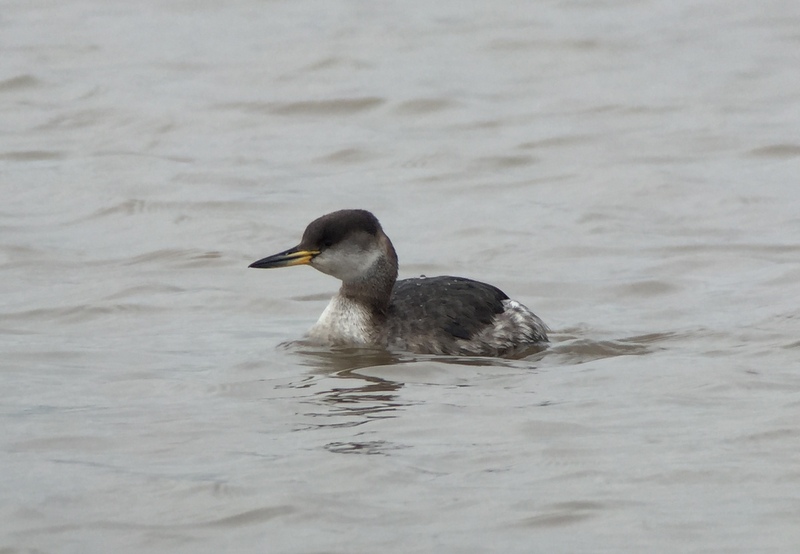 Red-necked Grebe – came right past us in the harbour channel
Red-necked Grebe – came right past us in the harbour channel
It surfaced a couple of times right in front, then the Red-necked Grebe swam up the channel away from us. We had planned to go to Flitcham this afternoon, but going back for the Red-necked Grebe had cost us time. At least with the weather improving, we thought the Pallid Harrier might be out hunting now. As it turned out, it had been there earlier but had flown off when the rain stopped. At least we hadn’t hurried over there and not seen the grebe as well, because we would have missed it anyway.
We had a good scan of the fields. Another Merlin was up in the sky some way away, hunting in exactly the same way as the one we had seen earlier, chasing some unlucky small bird. Once again, we did not see the outcome as they both dropped down out of view.
The hedges here are alive with finches – Chaffinches, Bramblings, Goldfinches – as a consequence of the cover strips and wild bird seed mix strips which have been sown around the edges of the fields and the over-wintered stubbles in various fields. This is how farms used to be, but modern agriculture and flocks of seed-eating birds seem to be incompatible unless food is specifically sown for them. In with the finches, we found several Tree Sparrows. This is one a the few remaining regular spots for them in Norfolk, a bird which used to be common. Again, a sad reflection of the impact of modern agriculture on our wildlife.
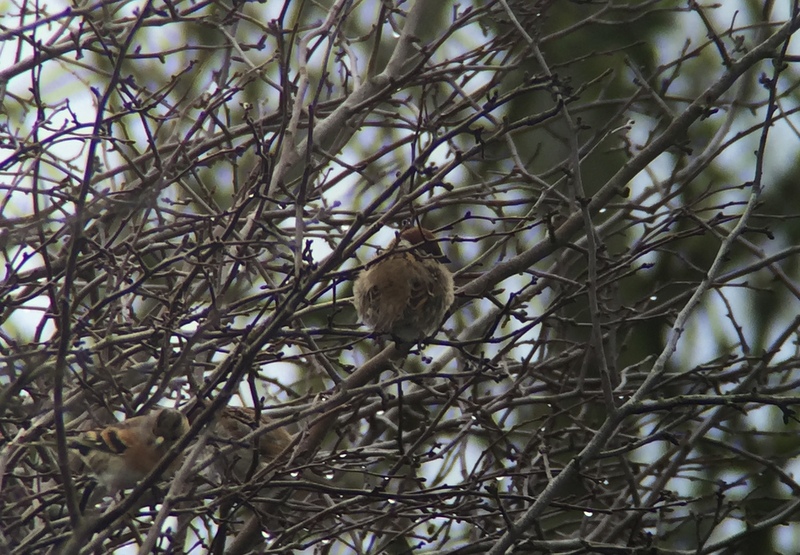 Tree Sparrow – in the hedge, with a Brambling bottom left
Tree Sparrow – in the hedge, with a Brambling bottom left
Although we had missed the Pallid Harrier at Flitcham, we still had one last card to play. While it has often been at Flitcham on and off during the day since mid December, it has not been known where it has been roosting. Last night it was seen going in to roost with Hen Harriers at nearby Roydon Common. So tonight, we decided to see if we could find it there. Several other people had the same idea, and left Flitcham before us.
We had just arrived at Roydon when we received a phone call from one of them to say the Pallid Harrier was there. We quickened our pace and got out to join them. It was a bit misty and drizzley again at first, although we could see the bird perched down in the grass. Then the sky cleared again and we got a better view – we could even see its collar now.
The Pallid Harrier then took off and flew round for a while – we admired its slim wings and pointed ‘hand’, giving it a rather falcon-like silhouette. We lost it, probably down on the ground, then the next harrier we saw was a ringtail Hen Harrier circling round. The Hen Harriers were starting to arrive, and we saw at least another two ringtails come in over the trees and drop down onto the common. The next time we saw the Pallid Harrier, it was flying again and this time with a Hen Harrier – it was great to see the two of them alongside each other. They even tussled a little, stooping at each other as they flew across the heathland. Then the Pallid Harrier dropped down again out of view.
It was a lovely way to end the day – and the weekend – out on the heath in the wilds of NW Norfolk, watching the harriers coming in to roost.
















